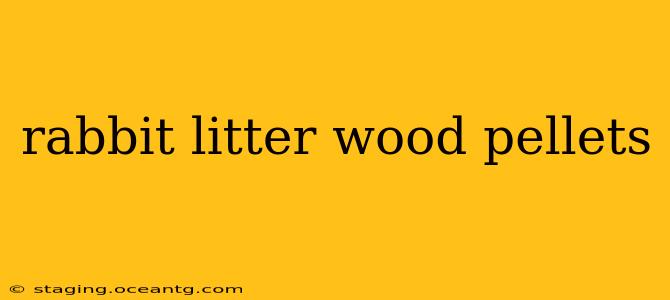Choosing the right bedding for your rabbit is crucial for their health and happiness. While many options exist, wood pellet litter has become a popular choice among rabbit owners. This comprehensive guide will explore the advantages and disadvantages of using wood pellets for your furry friend, answering all your burning questions.
What are Wood Pellet Rabbit Litters?
Wood pellets are made from compressed sawdust and other wood byproducts. These pellets are highly absorbent, making them an effective option for controlling odor and moisture in rabbit cages. They come in various sizes and wood types, each with slightly different properties. The most common types include pine, aspen, and fir. It’s important to note that the type of wood used can affect the suitability for your rabbit; some woods contain phenols that can be harmful.
Are Wood Pellets Safe for Rabbits?
This is a frequently asked question, and the answer isn't a simple yes or no. Many wood pellets are safe for rabbits, but the crucial factor is the type of wood used. Avoid cedar and pine pellets as these contain phenols, which can be toxic to rabbits if ingested. Aspen and fir are generally considered safer options. Always check the packaging to ensure the pellets are specifically marketed for small animals and are dust-free.
What are the Benefits of Using Wood Pellet Bedding for Rabbits?
- High Absorbency: Wood pellets effectively absorb urine and keep the cage dry and clean. This reduces the risk of ammonia buildup, which can cause respiratory problems in rabbits.
- Odor Control: Their absorbency contributes to better odor control, keeping your home smelling fresh.
- Cost-Effective: Compared to other bedding materials, wood pellets can be a more economical option in the long run, especially if purchased in bulk.
- Easy to Clean: Spent pellets can be easily scooped and disposed of, simplifying the cage cleaning process.
- Dust-Free (Ideally): High-quality wood pellets are dust-free, minimizing the risk of respiratory irritation for both you and your rabbit.
What are the Drawbacks of Using Wood Pellets for Rabbits?
- Potential Ingestion: Rabbits may occasionally ingest some pellets, which is generally harmless with safe wood types but can pose a risk with harmful varieties like cedar or pine.
- Sharp Edges (Potential): Some pellets may have sharp edges, potentially causing minor abrasions on your rabbit's paws. Choosing well-rounded pellets minimizes this risk.
- Not as Soft: Wood pellets are not as soft as some other bedding materials, which might be a consideration for older or delicate rabbits.
Are Aspen Wood Pellets the Best for Rabbits?
Aspen wood pellets are frequently cited as a good choice for rabbit bedding due to their low phenol content. They are generally considered safe and offer good absorbency and odor control. However, individual rabbits can react differently to different materials. Always monitor your rabbit's behavior and health after introducing any new bedding.
Can I Use Other Types of Wood Pellets Besides Aspen?
While aspen is a popular and safe option, other wood types like fir are also generally considered safe for rabbits. However, it's crucial to always check the packaging to confirm the pellets are specifically formulated for small animals and are free from harmful chemicals or dust. Never use cedar or pine pellets.
How Often Should I Change My Rabbit's Wood Pellet Bedding?
The frequency of bedding changes depends on your rabbit's habits and the size of their cage. As a general guideline, you should spot-clean the cage daily, removing soiled areas. Complete bedding changes should be performed at least once a week or more frequently as needed to maintain a clean and hygienic environment.
How Much Wood Pellet Bedding Do I Need?
The amount of bedding you need will vary depending on the size of your rabbit's cage. Generally, you'll want a layer deep enough to absorb urine effectively, typically several inches. It's better to start with more than you think you need and adjust as necessary.
In conclusion, wood pellets can be a safe and effective bedding choice for rabbits, provided you select the right type of wood. Always prioritize safety by opting for aspen or fir pellets specifically designed for small animals and free from harmful chemicals or dust. Regularly monitor your rabbit's health and well-being after introducing any new bedding material.
